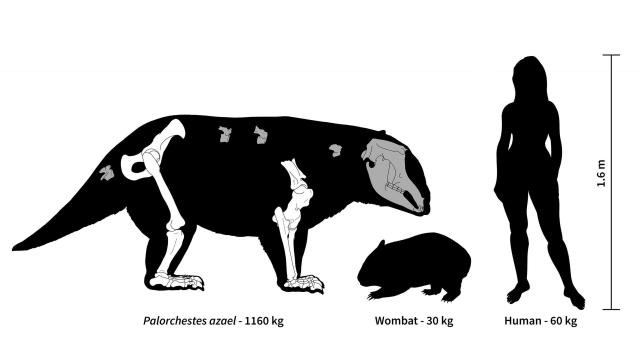Australia currently hosts some of the most upsetting animals known in the world. But researchers this week are keen to point out that incredibly strange animals have lived there for thousands of years — namely a group of extinct giant marsupials that likely weighed over a ton, wielded long claws, and had weird-arse elbows that couldn’t bend.
The animals belong to an extinct family of marsupials called Palorchestidae. They likely first showed up over 20 million years ago and may have survived as recently as when modern humans arrived on the continent, at least over 10,000 years ago. When scientists discovered their jaw fossil remains in the 19th century, they were initially mistaken as ancient kangaroos. But nowadays, they’re thought to have roughly looked like a giant wombat with a big tail.
Compared to other groups of related extinct marsupials, palorchestids haven’t garnered as much attention or scientific focus.
The authors of this new study, published Thursday in PLOS-One, say theirs is the first formal attempt to detail how the bodies of these animals, more specifically their limbs, may have looked and functioned.
Their work is based on more than 60 fossil specimens obtained from a half dozen museums in Australia and the UK, from three identified species. These fossils include partial skulls, hind legs, tail bones, and forelegs. They also used other extinct giant and living marsupials as a reference point.
From these fossils, they found that as these animals evolved, they got progressively bigger. And the species Parlorchetes azael — thought to be the most successful and recent-living member of the family — was likely even heftier than previously assumed. It might have weighed over 907kg and stretched out longer than the average human.
It’s already thought that P. azael and other palorchestids had enlarged “scimitar-like” claws that were ideal for slicing, clinging, and raking. But the authors also suspect that their forelimbs were especially muscular. And by the time P. azael had emerged, they seem to have developed elbows that were completely rigid, permanently held at a 100 degree angle relative to the body. If that’s true, that would make them the only known mammal, living or extinct, to have such unusual limbs.
As horrifying as a horse-sized wombat with razor-sharp claws might be to imagine, they were almost certainly gentle giants, being herbivores. Their rigid but powerful limbs and claws could have made them especially good at scrounging up vegetation, while they might have also occasionally stood on their hind legs to feed. But given their size, they probably never climbed or lived in trees like modern-day marsupials such as koalas.
Combined with research illustrating the weirdness of their heads — which may have sported a skull very similar to that of a modern-day tapir, lips incredibly good at gripping things, and a long, extendable tongue — the authors say their findings could cement these creatures as “one of the strangest marsupial lineages ever to have existed.”
Because palorchestid fossils are relatively scarce, though, there’s plenty we don’t know about them and their lives. The same goes for other marsupial megafauna in Australia, with scientists still debating what exactly caused these giant animals to go extinct (one common theory is that humans helped the process along by overhunting them).
The authors hope that future fossil finds, along with identifying already uncovered fossils in museums, will provide more insight into these hefty creatures.
